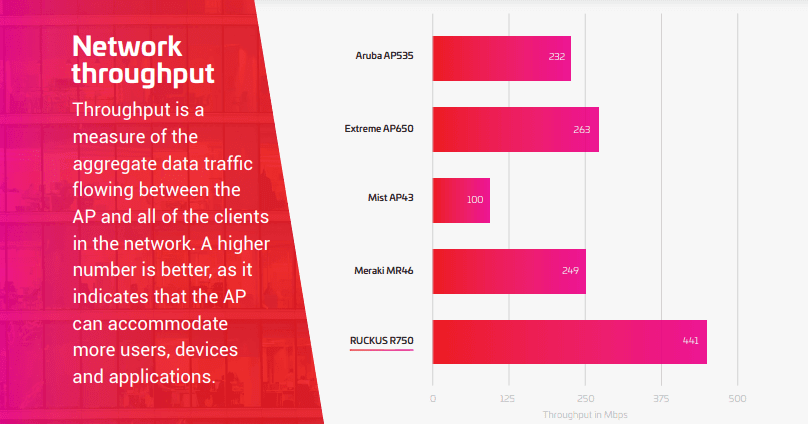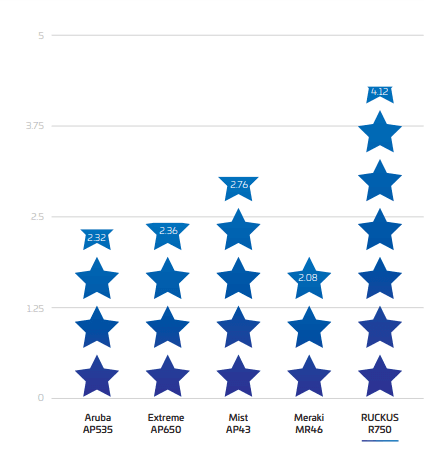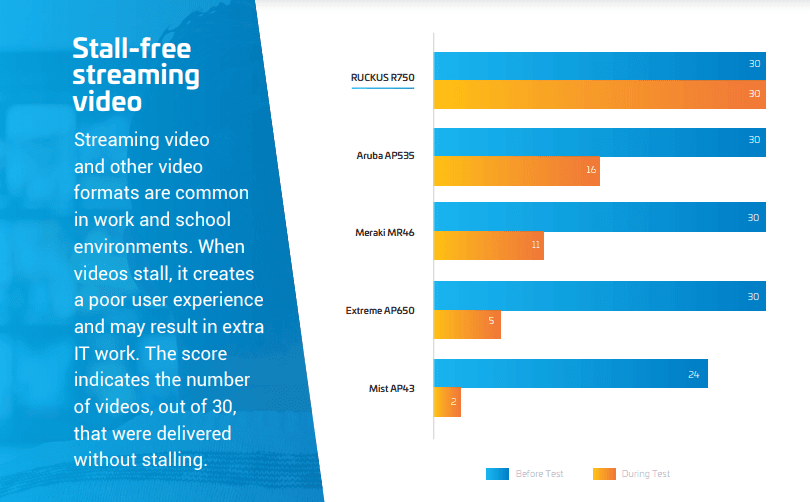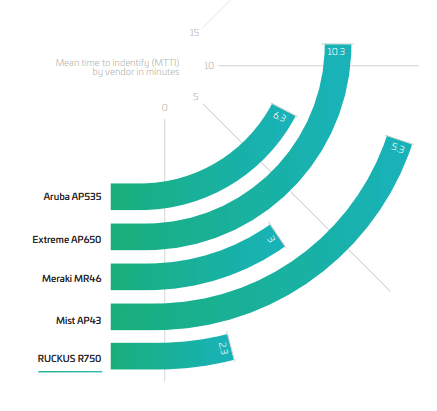Cloud-managed Wi-Fi 6 APs performance test
Which cloud-managed Wi-Fi 6 access points (APs) perform best under pressure? In March 2021, a Packet6 test of cloud-managed Wi-Fi 6 access points (APs) put 4-stream APs, five cloud-managed, under pressure in a high-density, real-world environment. Under 60 simultaneous voice, data, and video demand clients, only the CommScope RUCKUS access points met enterprise-grade service result and levels.
Why the Wi-Fi performance test is important
Wi-Fi still goes on to be the most widely used means to access network connectivity. Today, enterprises are leveraging mobile devices with low-latency, real-time applications; and mission-critical applications demand reliable, high-performing Wi-Fi. In hotels, guests rely on a stable Wi-Fi network to join video conferences in their rooms. In classrooms, laptops and tablets consume multimedia for instructional purposes. As a result, video use and video traffic volume is increasing alongside VoIP and data consumption, it is important to understand the impact network loading has on end-user experience for these applications.
The goal of this test was:
- Determine the performance level of the vendors' access point (AP)
- Assess how each vendor’s corresponding cloud solution helps IT teams minimize the mean time to identify (MTTI) an issue.
The goals were evaluated in a high-capacity, high-density environment where cloud managed enterprise APs were required to provide reliable service to the corresponding devices. In the event of network failures of any kind, IT teams need to be capable of quickly and reliably identifying the root cause. Most organizations are moving from on-premises controller based devices to public cloud based control and management. This test showed how each cloud solution measured up to today’s needs.
Best Wi-Fi 6 AP
Best Wi-Fi 6 AP
The Packet6 test challenged each AP to prioritize and manage traffic associated with:
- 30 Wi-Fi 6 laptop clients that were streaming 1080p video
- 20 Wi-Fi 5 laptop clients downloading data
- 5 Wi-Fi 5 tablets also downloading data
- 5 Wi-Fi 5 tablets running bi-directional and simulated VoIP calls
Out of the 5 APs in test, the RUCKUS R750 was the only AP that:
- Delivered stall-free video to all 30 clients
- Provided a “good” (MOS) mean opinion score to the VoIP call clients
- Delivered nearly twice the throughput of the other APs.
Test Conditions in simulation
- Two rooms simulating an educational or office environment
- Out-of-the-box Access Point configuration
- 80 MHz-wide channels
- Real-world client mix of f Wi-Fi 5, Wi-Fi 6, and mobile devices, Wi-Fi standards and OSs.
Best Wi-Fi put to test
The test challenged each AP to manage and prioritize traffic associated with:
- 30 Wi-Fi 6 laptop clients that were streaming 1080p video
- 20 Wi-Fi 5 laptop clients downloading data
- 5 Wi-Fi 5 tablets also downloading data
- 5 Wi-Fi 5 tablets running bi-directional and simulated VoIP calls
Out of the 5 APs in test, the RUCKUS R750 was the only AP that:
- Delivered stall-free video to all 30 clients
- Provided a “good” 4.12 (MOS) mean opinion score to the VoIP call clients
- Delivered nearly twice the throughput of the other APs.


Voice Mean Opinion Score (MOS)
Voice MOS is an often used measure of user-perceived voice quality during VoIP or PSTN calls. The higher the Voice MOS score, the higher the call quality. In a high-performing network, voice traffic is prioritized over other data traffic to ensure high call quality.
Most APs with a heavy network load do not prioritize voice traffic correctly thus may not have the capacity to maintain an adequate MOS, as users would perceive. MOS is a function of latency, jitter and packet loss. The table shows MOS index against user-perceived voice quality.
On the MOS metric, RUCKUS R750 outperformed the other APs, delivering higher call quality under heavy network load. Specifically, except the R750, no APs supported a MOS value that would meet enterprise SLAs requirements of “good” voice quality.


Mean time to identify (MTTI)
MTTI is the time an IT admin needs to determine the root cause of a network issue or incident. A shorter MTTI results in less troubleshooting burden on IT, higher effectivity of IT, and better user experience for clients.
Why is Ruckus better?
Reliable Wi-Fi connectivity while under real-world stress | Better real-world application performance for every client | Up to two times greater throughput, supporting more users and devices |
Out-of-the-box QoS mechanisms that ensure high-quality VoIP calls | AI- and ML-powered analytics that reveal root cause faster | |
